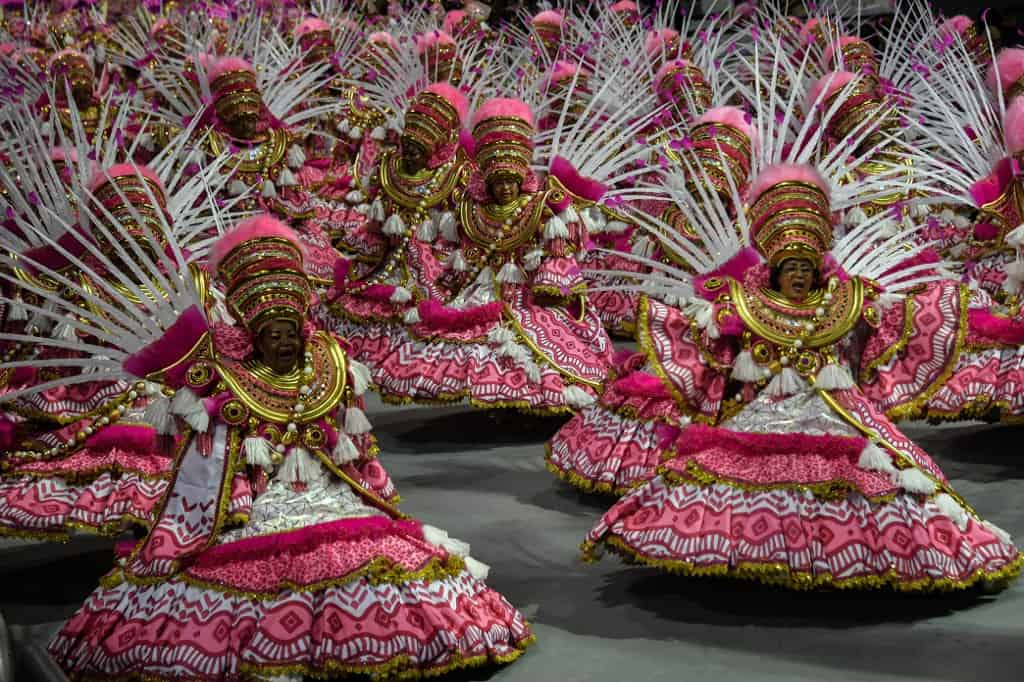Proudly, Regina Coeli adorns herself with a spectacular crown of green and orange feathers. She prepares to parade in a “escola” in a town in the interior of Brazil, with the “luxury” material that the Rio Carnival discarded after only one use.
After the parades at the Sambadrome, every year thousands of costumes made for months by the samba schools are abandoned at the exit. In the absence of an official recycling policy, opportunists, vendors and modest groups take advantage of the situation and go on the hunt for decorations and costumes.
The “escola” of Coeli, in Capim Branco, 500 km northwest of Rio de Janeiro, was a pioneer when a decade ago they traveled for the first time to the “mecca” of carnival and filled their van with discarded garments, says its president, Maria Lúcia de Souza.
They reuse everything: “Some costumes can be used whole, what we can’t use, we take apart, wash the fabrics, remove the stones and make other costumes,” explains this 75-year-old retired teacher in the shed of her house turned into a bustling workshop.
Capim Branco, with a population of 10,000, will celebrate Carnival on Sunday and Monday, with some 150 participants – compared to 30,000 at the Sambadrome – but with 80% of the material recycled from Rio.
Coeli, 59, tries on a sumptuous costume to match her crown, marked by orange and gold and bangs that give flight to a cape about two meters wide.
“It’s the luxury of trash,” says this art teacher, employing a play on words in Portuguese: “O luxo do lixo.” “Everything is done with such care (…) The result is sensational It leaves nothing to be desired!” she adds.
Priceless
Between seamstresses, makeup artists and helpers of various trades, about 15 volunteers star in the hustle and bustle of the workshop, which this year is back in full swing after the mayor of Capim Branco suspended the parades in 2017.
Amid this visual glee, a splendid silver mask with onerous natural feathers or a puffy pink dress adorned with dazzling bunting stands out.
“These costumes have an inestimable value for us and for the environment too because we take advantage and reuse,” explains the president of the “escola” ESUCAB, from Capim Branco.
Although the big samba schools in Rio recover part of their work, it is difficult to control that all the garments return to their sheds. What ends up on the street after the parade is recovered by third parties or is taken away by garbage collectors along with the mountains of cans, bottles and other waste generated by the party.
“The first year we went to the Sambódromo, we saw a garbage truck that directly shredded the costumes,” Souza recalls.
His team’s method is simple: “We arrive, put a tarp on the ground and on a wall we write ‘The Capim Branco samba school thanks you for your donation'”.
Non-natives on the front line
Although the parades at the Sambódromo are made up of thousands of members of the “escolas” who rigorously rehearse all year round, it is also possible to participate in the carnival delirium by paying around $500.
“We mainly target foreigners, who can’t take home” the bulky costumes, says Souza.
One of Rio’s historic “escolas”, Viradouro, explained to AFP that the recovered costumes “are reused” and those that are not donated or sold to smaller samba schools.
Carnival in Brazil generates a total of 3,500 tons of waste in the main cities, including Rio, according to the Retornar Foundation, which calls for the reduction of plastic and the “reuse of costumes and float materials” in a country where only “4% of solid waste is recycled”.
This year, organizers in Rio launched an ambitious recycling operation, with the goal of making the Sambadrome party “one of the largest ‘zero waste’ events on the planet”.

